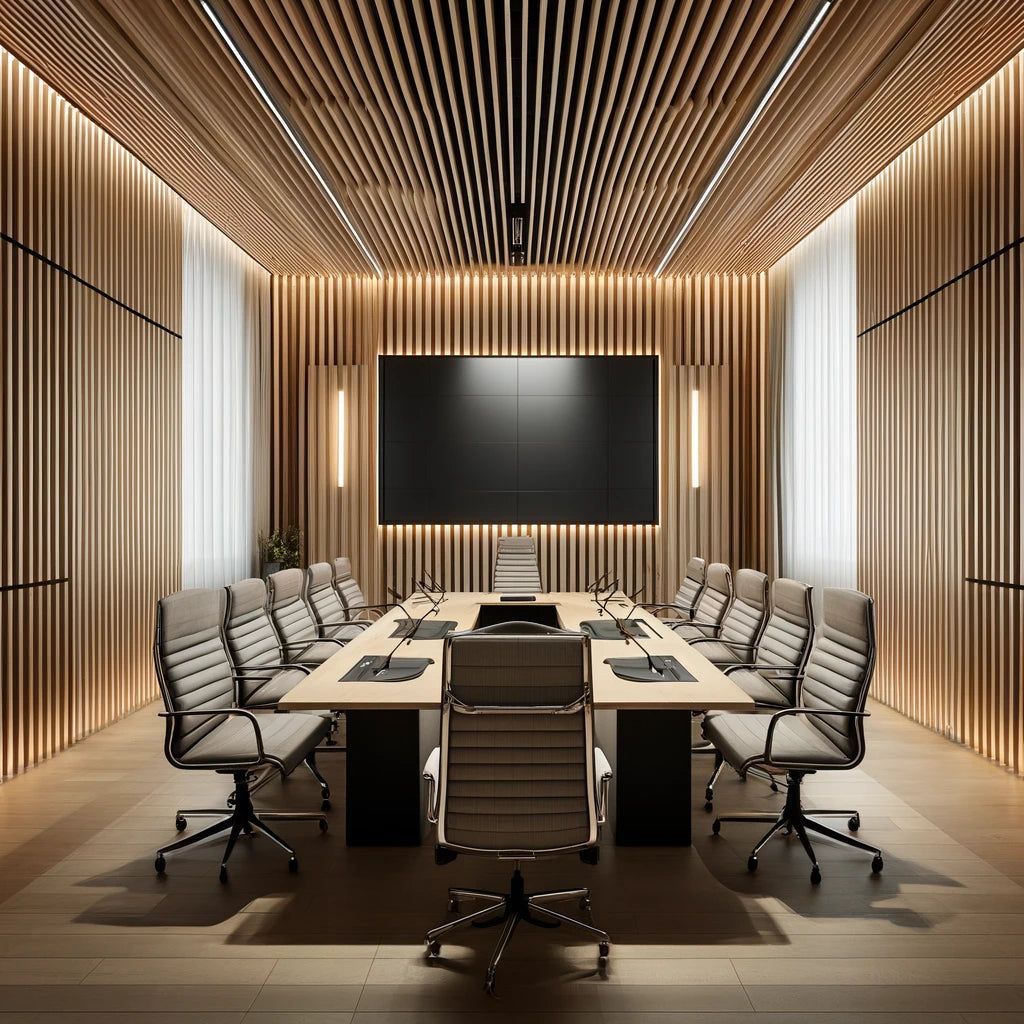Acoustic Wall Panels: Elevate Your Conference Room Harmony
Are you struggling with noise issues in your conference room? Acoustic wall panels can be the perfect solution to create a more harmonious and productive environment. In this blog, we’ll guide you through the benefits, installation process, and tips for choosing the right acoustic wall panels. Ready to transform your space? Read on to learn more and check out our extensive collection of acoustic wall panels on our website.
Why Choose Acoustic Wall Panels for Your Conference Room?
Acoustic wall panels offer numerous advantages that make them an excellent choice for improving your conference room’s ambiance and functionality:
Enhanced Sound Quality
Acoustic wall panels are designed to absorb sound, reducing echoes and minimizing background noise. This leads to clearer communication during meetings and presentations.
Improved Focus and Productivity
By reducing noise distractions, acoustic wall panels help create a more focused and productive environment, essential for brainstorming sessions and important discussions.
Stylish and Versatile
Available in various designs, colors, and textures, acoustic wall panels not only improve sound quality but also enhance the aesthetic appeal of your conference room.
Step-by-Step Guide to Installing Acoustic Wall Panels
Tools and Materials You'll Need
Before starting the installation, gather the following tools and materials:
- Acoustic wall panels
- Measuring tape
- Level
- Pencil
- Adhesive (specifically for acoustic panels) or nails
- Saw (if panels need cutting)
- Sandpaper
- Caulking gun
- Caulk
- Paint (if needed)
- Safety gear (gloves, goggles)
Step 1: Prepare Your Walls
Cleaning and Smoothing the Surface
Start by cleaning the surface of your walls thoroughly to remove any dust, dirt, or grease. Use sandpaper to smooth out any rough areas or imperfections. This preparation ensures that the acoustic wall panels adhere properly to the wall.
Measuring and Marking
Measure the dimensions of your wall and mark where each panel will go. Use a level to ensure your lines are straight. Accurate measurements and markings are crucial for achieving a professional finish.
Step 2: Cutting the Panels
Measuring and Marking the Panels
Measure your acoustic wall panels to fit the dimensions you marked on the wall. Use a pencil to mark the panels where they need to be cut.
Cutting the Panels
Using a saw, carefully cut the panels to the required size. Ensure you wear safety gear during this step to protect yourself from dust and debris.
Step 3: Applying Adhesive
Choosing the Right Adhesive
Select an adhesive suitable for the type of acoustic wall panels you are using. Some panels may require specific adhesives, so check the manufacturer's recommendations.
Applying the Adhesive
Apply the adhesive to the back of the acoustic wall panel in a zigzag pattern. Be generous but avoid applying too much adhesive, which can cause the panels to slip or not adhere properly.
Step 4: Installing the Panels
Placing the Panels on the Wall
Carefully press the panel onto the wall, starting from the bottom and working your way up. Use a level to ensure the panel is straight. Press firmly to ensure good adhesion.
Securing the Panels
Depending on the type of acoustic wall panels and the adhesive used, you may need to secure the panels with nails or screws temporarily until the adhesive sets. Follow the manufacturer's instructions for the best results.
Step 5: Finishing Touches
Filling Gaps and Seams
Once all the panels are installed, check for any gaps or seams between them. Use caulk to fill these areas for a seamless look. Smooth the caulk with your finger or a caulking tool.
Painting (If Needed)
If your acoustic wall panels are paintable, consider adding a coat of paint to enhance their appearance. Choose a paint color that complements your conference room’s decor.
Final Inspection
After the panels are installed and any paint or caulk has dried, inspect your work. Ensure all panels are securely attached and that there are no visible gaps or imperfections.
Tips for Choosing the Right Acoustic Wall Panels
Consider the Room’s Purpose
Think about the primary use of the conference room. Different activities may require varying levels of sound absorption. For instance, a room used for frequent video conferences might need more absorption than one used for occasional meetings.
Match the Decor
Choose acoustic wall panels that complement your existing decor. This ensures that the panels not only improve acoustics but also enhance the overall aesthetic appeal of the room.
Quality Matters
Invest in high-quality acoustic wall panels. While they might be more expensive initially, they offer better sound absorption and durability, providing long-term benefits.
Ready to Enhance Your Conference Room?
Transform your conference room into a harmonious and productive space with acoustic wall panels. For a wide range of designs and styles, visit our website and explore our stunning collection of acoustic wall panels. Whether you're aiming for improved sound quality or a stylish upgrade, we have the perfect solution for you. Get started today and experience the difference!

